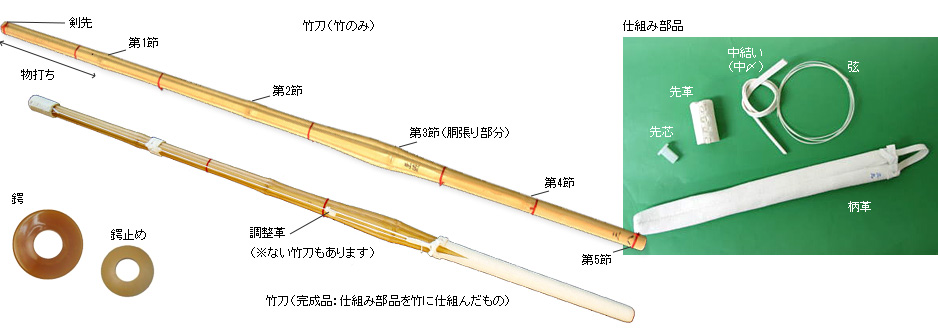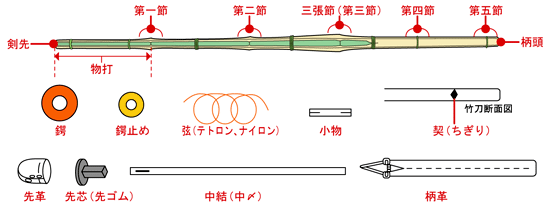Plans for a vegan shinai for kendō
Recently I have taken up kendō (Japanese fencing) again, after a hiatus of… gods. 20 years, give or take.
I'm having a blast. My body remembers the movements much better than I expected, and I find all the screaming while whacking people on the head to be wonderfully therapeutic. Alas, a lot of the equipment is leather-based. I had assumed by now someone would have come up with alternatives as in most sports, but I assumed wrong. Oh well. (This article has talk of leather, and photos of leather parts.)
Some things I cannot find a way around at all, like certain attachment parts of the body armour. You can buy* armour where the big chunks (like the gauntlets) are made of plastic “clarino” leather; if anything I think that’s rather the norm nowadays outside of competition settings.† But critical tensioned parts like the metal face protector seem to be always animal skin. Kendo24 has an “almost 100% leather-free orizashi‡ bōgu”, for example. But if you have to buy leather anyway it would probably be best to get used armour—and cheaper, too.
The other big presence of leather in kendō is the bamboo sword used for sparring, the shinai. It has leather fittings including the guard (tsuka 柄), the tip protector (sakigawa 先革), the middle knot (nakayui 中結い/nakajime 中〆)⸸ that marks the good striking area, and optionally a little thingie to help the string stay centred, called an adjustment leather (chōseigawa 調整革) or, amusingly, komono 小物 (“little thingie”).

 Source for images: Kendō Kyōto 1, 2.
Source for images: Kendō Kyōto 1, 2.
In past discussions about the lack of vegan gear for kendō, people have raised the suggestion of crafting your own fittings from some vegan material. Elaborating on this idea and after some research, here's my plan so far for a vegan shinai:
Get a used shinai from someone, with the leather guard. There's not much way around this, I think. I need a model, and information is scant. Shinai are halfway disposable and especially the tsukagawa is not given much attention, the general attitude is “eh it's just a tsukagawa, if it's too nasty throw it away and get a new one”.
Buy a premium shinai without fittings from Japan, e.g. something with madake. This is overkill for a casual like me, but it's still not that expensive (again, shinai being kinda disposable), and it's the only way you can get the bamboo slats without a tsukagawa.
Buy polyester imitation of rough suede/raw leather, probably the type sold for use in furniture or car furnishings. The properties we're looking for is: a. Must be rough, for friction in the grip; b. Must be white (or at least beige or light gray) and look similar to typical tsukagawa, to fit in the dōjo; c. Must be as strong as possible, for tensile and especially shear strength.
Disassemble the used shinai, and double-check whether the leather pieces fit the new one. Then undo the bindings of the leather. Trace all the leather pieces on paper, and cut the polyester leather on this model. Secure the edges with a small backstitch in matching thread (+blanket/whipping? I don't think hemming would be a good idea.) I don't like the idea of using even more plastic but seamstresses usually recommend natural-on-natural and synthetic-on-synthetic, so probably polyester thread of a matching colour is best here. Better yet, go all the way with kevlar thread for the best strength. (UHMWPE is even stronger against shear, but kevlar is better at dealing with friction and impact. I'm overthinking this, the polyester would be fine but hey, what's the point of DIY if you don't overthink things.)
Re-bind the old leather pieces and reassemble the old shinai. Then while the details are still fresh in the mind, sew the plastic leather pieces. I'll also probably reinforce them (see “Open Questions” below). Bind and fit into the new shinai.
Stress test both shinai before bringing them to the dōjo.
Keep using the old shinai to its limit. Every time you pick it up, reflect on the poor animal who underwent a life of constant abuse and an ignominious death merely for human convenience, and how dismissively humankind trivialises the pointless, ongoing atrocity of animal objectification. Then remember that vegans are not immune to the wheel of karma, and every one of us owes our continued existence to the work and suffering and death and life of countless plants and animals and microbes and other beings, and how every piece of luxury we have costs the unsung sacrifice of the working class. Remember that you are not superior to non-vegans, and you probably have your own biases that make ongoing tragedies as invisible to you as the animal industry is to non-vegans. Bearing the full weight of this, treat your old shinai as a priceless treasure; oil and care for it and rotate the slats and sand splinters if they pop. Become an expert in shinai maintenance, until assembling and treating and reassembling feel as natural as waving it around. When the shinai finally gets too beaten up to keep using safely, your fancy one will be waiting, and maybe you'll have earned enough skill to be worthy of the stuff.
Open questions
What exactly are the material parameters of the leather used in tsukagawa? Can we be reasonably sure we match shear strength, etc.? Is it possible to have a vegan shinai pass regulations?
Stretch goal: Can we make a tsukagawa that's not just vegan but plastic-free? Most vegan leathers include at least some plastic, and almost nobody is making rough or suede textures. Amadou (mushroom leather from Romania) is a material that's fully sustainable and low tech, looks wicked cool, and seems plenty frictiony; but it would draw attention, and I think it's not very resistant? Could cork leather be used somehow, at least in the sakishin?
Can we reduce plastic use in the rest of the shinai? Would it be safe to use a plant fibre for the tsuru? Maybe hemp or linen cord, twisted not braided, maybe a notch thicker than usual. Condition it with oil (ideally jojoba or tsubaki) for increased durability, inspect often, and replace at any signs of distress. I have no idea how to test if this is good enough.
People normally don't even try to care for their tsukagawa. If I have to buy leather, even used, I want to give it maximum respect. How do you maintain suede? Is there a way to remove the kendō grease stains? Online sources all agree to keep bleach and water the hell away from it (though when I look it up in Japanese I see people simply spraying theirs with laundry cleaner and brushing with a toothbrush, but it's not like, professional kendō players). In other contexts, people who want to clean oil stains or bleach the tint of suede sneakers use powders: talcum, or bicarbonate, or powdered rosin (colophony). What about maintenance for increased durability, is there anything you can do? Oiling suede just makes it greasy, but wax is a possibility (mokurō? carnaúba?). It's unclear to me whether that would make a tsuka too slippery.
Can I reinforce the tsukagawa for durability? I can't see a reason why not, other than “it's not traditional” or “it will look different”. I bet even the animal suede could be reinforced with sashiko (the stitching not the weaving), but what I'm thinking for the vegan model is: sandwich 3 layers of textile, the polyester suede, then thin linen from a bedsheet, then suede again. The idea is that inner and outer faces are abrasive and grip onto the hands/bamboo, and the inner lining acts as a soft buffer so the suedes don't constantly scratch one another. Linen is my pick because it's thin, soft, strong, and quick-drying. (I personally think kendō uniforms should all be thick linen jersey or sashiori rather than cotton). Then I wouldn't just sew the edges (you don't want any of the layers moving against one another) but bind the entire surface with a small sashiko cross pattern (jūjizashi). If you never handled a sashiko patch before, it's kind of magic how much tougher and more resistant it makes a textile, to interweave it with thread. I'm willing to bet that a material prepared like this would last longer than a normal tsukagawa, and it would look pretty and Japanese too. Maybe a bit too pretty, but if you match the thread colour to the polyester suede, I bet people wouldn't even notice the grid lines unless they paid close attention.
For now all of this is just ideas; I’ll simply accept my sadness and buy an used shinai from someone in my area, get familiar with disassembling it, reassembling it, caring for it. If I ever go ahead with the idea of a polyester tsukagawa, I'll post photos here, as well as the models, dimensions etc.
My current picks
For the leather: Novely Lathen. Mostly because it has a passable look and textured surface, while also providing technical specifications for rub fastness and abrasion (which means they care about it). Sadly they don't seem to make the white colour anymore, but the “silver gray” looks kinda like an used tsukagawa. Their Moers product has heavier grammature, but it seems to be softer to the touch, and the resistance numbers are slightly lower.
For the shinai bamboo: Onimaru kotōgata (local seller).
This is a kotō or “old sword” shape shinai, made with the resistant madake banboo. Kendō players who focus on competition usually prefer dobari, or “belly out” shape, which puts more weight near the handle, making for quick movements of the tip. A kotō-gata is at the opposite end of the spectrum; the weight is distributed along the length, making it comparatively heavier at the tip. The handling that results is more technical, and closer to how a sword feels. Dobari are easier to combo, to react quick with a snappy tip; kotō favours well-timed, single, decisive strikes.
Again, all of this is overkill for someone at my level, the details don’t matter so much for casuals. But there are some desirable traits outside of competition; the balanced shape is more durable, and the heavier tip forces you to swing nice wide arcs with good form, being therefore of pedagogical value. It's also good for people like me who are interested in koryū, HEMA etc.; more skill transfer.
I don't particularly like that it's a tsukafuto (thick handle), and ideally would prefer something like Sumire, a shinai that’s woman-sized and even more “kotō” than most kotō. But I'm limited in what I can access within the EU, and even if I paid import taxes from Japan I can't find Sumire sold bamboo-only anyway. And yeah, my grip strength can't compare to men’s, but I do lift weights and I'm tall with large hands for a woman, I think I can handle a size-39 thicc bottom. It's not like I'm aiming to be the ZNKR champion after (re)starting kendō at 42 years old and training once a week. The purpose of kendō is, quote, “to encourage the practitioner to discover and define their way in life through training in the techniques of Kendo”, endquote; this is me discovering & defining my way of life.